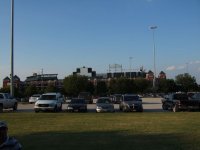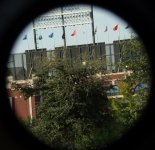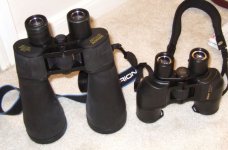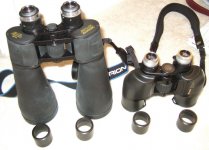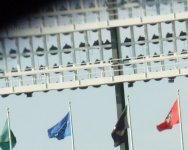Replacing eyepieces ... very interesting.
This is the link for their "astro" oriented (i.e. 50mm objective) bins. It would be nice to see them on "smaller" (40mm) bins.
He has some photos but they're not quite before and after at the same size which would have facilitated a comparison. But the FOV photo os a grid is quite good.
http://www.siebertoptics.com/SiebertOptics-modifiedbinoculars.html
Many people think that the Objectives and prisms have more to do with the quality of view then the eyepieces. Is this true? NO!, not at these magnifications. A quality 50mm objective could be pushed to 100 times without a failure. Most binoculars objectives can easily be pushed to half of that. These binoculars do not have to go nearly that high but as you see in the pictures at the bottom of the page they could go to 40x. In this case prisms are not the bottleneck. It is the failure of the eyepieces that brings down most binoculars which in this case is easy to fix.
The replacement eyepieces are not wide field at 50deg but are razor sharp to the edge of the field and have be given a lot of attention as to collimation so the stars blend into one without problems.
They also have separate adjustable eye focus and a user collimation adjustment.
So do you end up with IF bins? Or can he retain CF on other modified units?
And is that price $299 for the 50mm the whole price (bin + eyepieces) or the upgrade price? I presume it's the former.
I suspect replacing porro's eyepieces is a lot easier than doing roofs as you have the freedom to remove the eyepieces and change the external dimensions of the new eyepeices. Roofs are a bit more constrained (another win for porros

)
EDIT1: The other point in the image of the Siebel 26mm eyepieces the field is flat with no pinchushion. I would expect this to show the "rolling ball" or "globe" effect (which you will get from an undistorted field). How much distortion is added seems to be a characteristic of the designer but in this case not enough (or there is a different shape to the distortion at the edge of the field).
See Holger's paper on this:
http://www.birdforum.net/showthread.php?t=74727
http://www.holgermerlitz.de/globe.pdf
Do the modified bins show the "globe" effect?
In your post I'm not quite clear: did you get this done to your 10x50 or the 8x42?
EDIT2:
There are a couple of threads on Cloudy Nights
Anyone using Siebert Optics modified binos?
http://www.cloudynights.com/ubbthre...1018771&page=0&view=collapsed&sb=5&o=all&vc=1
edz said:
We have had considerable discussions about these binoculars in this forum at some time in the past.
One of the reasons that far less distortion will be seen in these binoculars is the huge exit pupil will be larger than most people's eye pupil, therefore the binocular will effectively be masked down.
In a 6x50 binocular, the exit pupil is 8.3mm. In general most users may have a 6mm eye or smaller. Some might have 7mm eyes. So effectively, this binocular will operate as if it were a 6x36, possibly a 6x42, reducing lateral CA, coma, distortion and curvature, even without better eyepieces.
and comments by Holger Merlitz
http://www.cloudynights.com/ubbthre...=245475&page=0&view=collapsed&sb=5&o=all&vc=1
holger said:
The apparent field of view of these modified binoculars will be rather narrow for sure. For example: If the original glass has got 70 degs. at 10x magnification, i.e. 7 degs true field, then, at 6x, it drops to 42 degs. apparent field, because the true field of view can't be improved much without an increase of the prism size. So these binoculars will likely come with a tunnel view. It were a better idea to keep the magnification constant and just replace the simple reverse Kellner oculars (as they are usually employed in low-to medium range binoculars) with his 6-lens construction.
I guess that's what he's doing in these current bins. But the argument (in these threads) about over-big exit pupils and your eye's entrance pupil effectively stopping down the bins to x40ish seems valid.
The threads are all worth reading.
I'd love to hear more about this.





